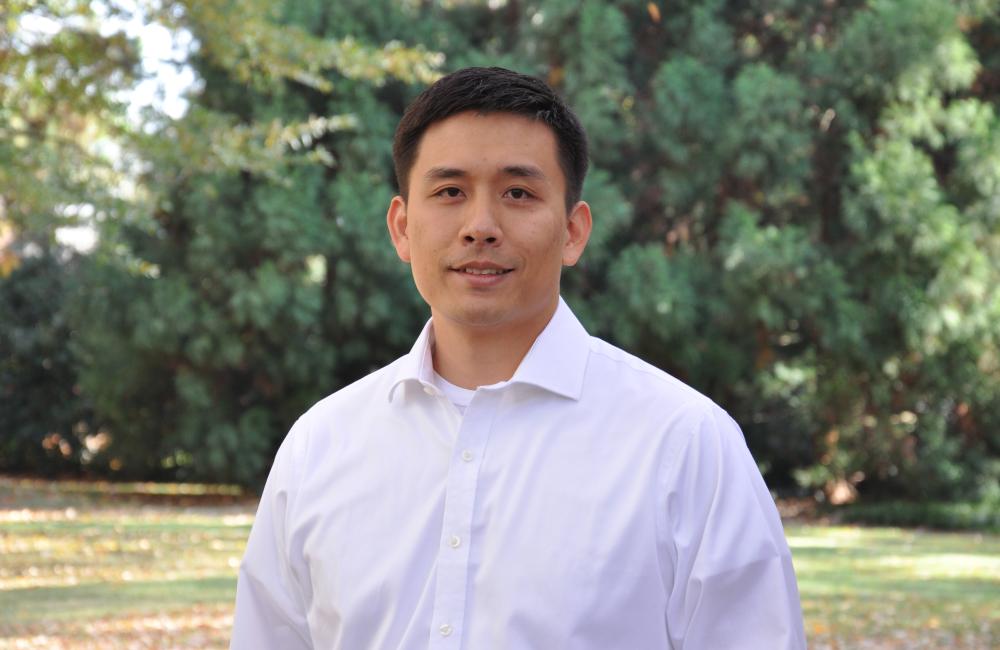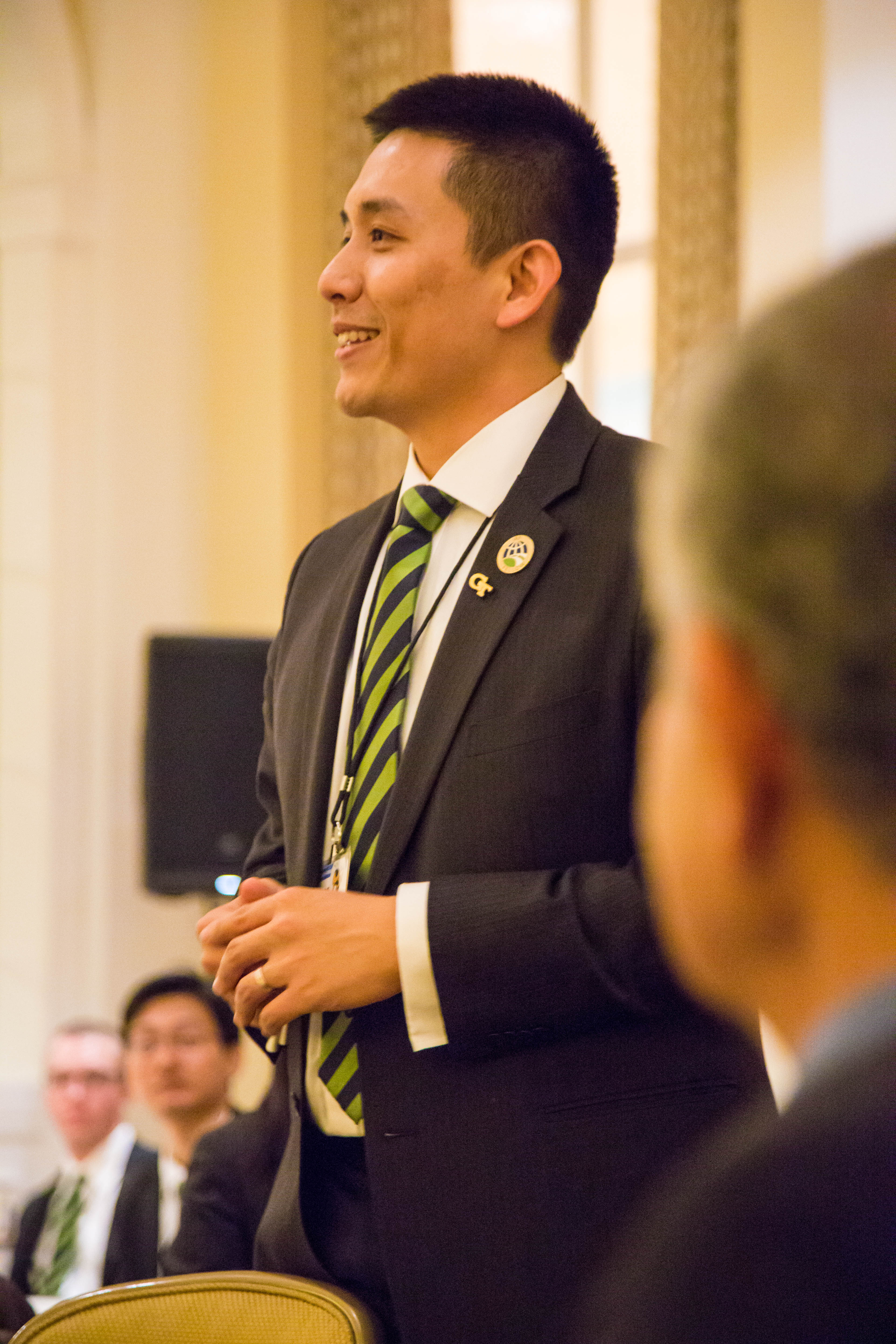
Ross Wang is leveraging his expertise in civil engineering, transportation systems, data analytics, and modeling and simulation in a variety of mobility projects at ORNL, including unsnarling traffic on some of the nation's most congested roadways. Credit: ORNL, U.S. Dept. of Energy
Ross Wang has been intent on resolving traffic jams since he rode a city bus every day through 40 minutes of traffic to get to his elementary school. That daily journey left an impression that would shape his career.
Years later on the front row of his civil engineering classes in college, Wang was eager to learn all he could about how cities and streets are managed. Today, Wang is leveraging his expertise in transportation systems engineering, data analytics, and modeling and simulation to unsnarl some of the nation's most congested roads as a researcher at Oak Ridge National Laboratory.
In Chattanooga, Tennessee, Wang and his colleagues are collecting data from hundreds of traffic sensors, including signal controllers and smart cameras, and using them for real-time situational awareness and energy efficient decision-making. He is helping develop signal timing and other solutions to tame traffic, cut fuel consumption by as much as 20% and reduce vehicle emissions. Wang is participating in a similar project in Honolulu, Hawaii, to optimize 34 intersections to reduce traffic delays and save fuel.
Wang is working on another project to create a system in which connected and automated vehicles, or CAVs, receive data from signal controllers and sensors to save fuel while driving. A CAV might receive information that an upcoming traffic light will soon turn red and can efficiently adjust its speed to arrive after the light turns green or coast to a stop rather than braking hard, he explained.
He and his fellow engineers also are incorporating a signal controller into a special X-in-the-loop environment, which enables hardware to be tested in a simulated ecosystem, at the National Transportation Research Center (NTRC), a U.S. Department of Energy-designated user facility at ORNL. The controller will be used along with the vehicle dynamometer and microscopic traffic simulation software in the Connected and Automated Vehicle Environment (CAVE) Lab at NTRC as researchers construct an interface among the lab's hardware and software for testing and analysis of both real and simulated systems.
National data, local solutions for the ORNL campus
Wang's work doesn't end there. He is also heavily involved in the lab's transportation data projects funded by the U.S. Department of Transportation, including the national household travel survey (NHTS) that seeks to give transportation planners across the country an understanding of travel behavior, and the freight analysis framework that provides detailed information on freight movements. The NHTS project is expanding with a recently added project to create a national bikeway network that will inventory existing bike facilities and help planners take into account non-motorized mobility.
Wang is even deploying his expertise to the roadways around ORNL to better understand traffic and parking issues and reduce emissions as part of the Sustainable ORNL initiative. He is using a digital twin of the campus and data on traffic and parking patterns to improve traffic signal controls as well as to inform decisions on additional parking, electric vehicle charging stations and potentially an automated shuttle. He is creating a parking app that would help staff find available spaces in the lots across campus.
All of these projects are related to data and control systems and, for Wang, it's literally a dream come true.
"Anything transportation really fires me up," he laughs. "Majoring in civil engineering means that I was exposed to engineering topics that are greatly embedded in our daily lives. That's everything from understanding structures, transportation, water resources, geotechnics, surveying and environments."
Traffic efficiency as a path to decarbonization
An understanding of the need for solutions to tame traffic, save energy and help decarbonize transportation is a key driver for Wang in his work. The transportation sector is the largest source of greenhouse gases in the nation, with cars and light trucks alone accounting for 60% of emissions. Solutions that cut fuel use also reduce related emissions.
Wang received his bachelor's and master's degrees in civil engineering from National Taiwan University, and then moved to the United States to pursue his civil and environmental engineering doctorate at the Georgia Institute of Technology. After graduating, he worked in infrastructure planning for the Florida Department of Transportation.
He got to know about ORNL while attending meetings of the Transportation Research Board (TRB), a National Academies of Sciences, Engineering, and Medicine organization that supports transportation research. Wang helped host a gathering of Taiwanese researchers at the TRB, and it was there he met Ho-Ling Hwang and Shih-Miao Chin, who lead the national transportation data projects at ORNL. He was hired at the lab in 2018.
Team spirit at home and at the lab
In his spare time, Wang plays acoustic guitar and enjoys singing choral music. Growing up, he performed as a vocalist with a semi-professional team. Today, his musical talents are mostly used at his church and to entertain his kids.
Working as part of a team is a comfortable environment for Wang in his professional life as well. Successful collaboration is key to the lab's success as his section, Vehicle and Mobility Systems Research, takes on research in a variety of transportation focus areas, Wang noted. "We have a flat structure here that's not as hierarchical, and that means everybody can work with anybody. I really enjoy that aspect of the lab."
Wang cites the support of his colleagues for the accomplishments of his section as a whole. "The team environment at ORNL is what I find so exciting. The knowledge base and research ideas follow each other into related areas, so what I learn from one project can be applied to another one simultaneously," he said. "I get to learn new things and apply them to the next opportunity. I like having that broad perspective and interests, and ORNL encourages that mindset."







